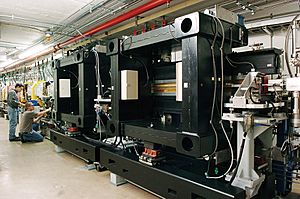Insertion device facts for kids
Have you ever wondered how scientists study tiny things like atoms or new materials? They often use incredibly bright light, much brighter than the sun! This special light comes from huge machines called particle accelerators. Inside these machines, there's a clever tool called an insertion device.
An insertion device is basically a special setup of powerful magnets. Scientists "insert" these devices into a straight part of a particle accelerator. Think of it like adding a special section to a race track. These devices are super important because they help create the amazing, bright light that scientists use for their experiments. They replace a section of pipe that would normally just hold a vacuum for the particle beam.
Contents
What is an Insertion Device?
An insertion device is a series of magnets placed very close together. These magnets are arranged in a way that makes a beam of tiny particles, usually electrons, wiggle or undulate as they pass through. When charged particles like electrons are forced to change direction, they give off energy in the form of light. The more they wiggle, the more light they produce!
Why are they "Inserted"?
These devices get their name because they are literally "inserted" into the path of the particle beam. Particle accelerators, especially those that make light, are often shaped like big circles or rings. The electrons zoom around these rings at nearly the speed of light. To make the special light, scientists need to add these magnet sections into the straight parts of the ring.
Where are they Used?
Most of the time, insertion devices are used in circular particle accelerators called synchrotrons or storage rings. These machines are designed to keep electrons moving in a circle for a long time, producing a continuous stream of bright light. This light is called synchrotron light.
Types of Insertion Devices
There are two main types of insertion devices, and they each make light in a slightly different way:
Undulators
An Undulator is a type of insertion device that makes the electron beam wiggle gently. This gentle wiggle makes light that is very specific, like a single color of the rainbow. Scientists can "tune" this light to a very narrow range of frequencies or colors. This is useful when they need to study something very precisely, like the exact structure of a molecule.
Wigglers
A Wiggler is another type of insertion device. Instead of a gentle wiggle, wigglers make the electron beam wiggle much more strongly. This creates a wider range of light frequencies, like seeing many colors of the rainbow at once. Wigglers are used when scientists need a lot of bright light across many different "colors" or energies.
Why is Synchrotron Light Important?
The super bright light created by insertion devices is incredibly useful for many areas of science. Scientists use it like a powerful microscope to see things that are too small for regular microscopes.
- Studying Materials: They can look at the tiny structure of new materials to make them stronger or more efficient.
- Medicine: Researchers use it to understand how medicines work or to develop new ways to fight diseases.
- Biology: It helps them see the detailed shapes of proteins and other biological molecules.
- Art and History: Even art historians use it to study old paintings without damaging them!
Insertion devices are a key part of modern science, helping us discover new things about the world around us, from the smallest atoms to complex biological systems.


